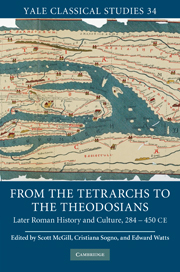Book contents
- Frontmatter
- Contents
- Acknowledgments
- Introduction
- PART I POLITICS, LAW, AND SOCIETY
- PART II BIOGRAPHY AND PANEGYRICS
- 6 Three generations of Christian philosophical biography
- 7 The education of Paulinus of Pella: learning in the late empire
- 8 Another man's miracles: recasting Aelius Donatus in Phocas's Life of Virgil
- 9 Gregory of Nazianzus's Life of Julian revisited (Or. 4 and 5): the art of governance by invective
- PART III FACES OF THEODOSIUS I
- References
- Index
9 - Gregory of Nazianzus's Life of Julian revisited (Or. 4 and 5): the art of governance by invective
from PART II - BIOGRAPHY AND PANEGYRICS
Published online by Cambridge University Press: 04 August 2010
- Frontmatter
- Contents
- Acknowledgments
- Introduction
- PART I POLITICS, LAW, AND SOCIETY
- PART II BIOGRAPHY AND PANEGYRICS
- 6 Three generations of Christian philosophical biography
- 7 The education of Paulinus of Pella: learning in the late empire
- 8 Another man's miracles: recasting Aelius Donatus in Phocas's Life of Virgil
- 9 Gregory of Nazianzus's Life of Julian revisited (Or. 4 and 5): the art of governance by invective
- PART III FACES OF THEODOSIUS I
- References
- Index
Summary
For [Ammianus, and others of his mind], much more was at stake than the acceptance of military defeat. The death of Julian was nothing less than the death of their hero, and a fatal blow to their hopes that the Roman empire might be renewed upon the principles of an earlier age.
[I]t is hard to imagine a writer more responsive to the issues and personalities of his time, and hard to think of a topic on which, however peripheral to his own preoccupations, he does not make some contribution to our understanding.
John Matthews, The Roman Empire of Ammianus, xOn 11 December 361 CE Flavius Claudius Julianus, aged twenty-nine, arrived in Constantinople as sole ruler of the Roman empire. A few months later an equally young man from a small city in Cappadocia apologized to his family and friends for a choice that few had anticipated: he wished henceforth to lead “the true philosophical life.” Two men, two signal events in their personal lives that stand paradigmatic for a phenomenon central to John Matthews's work: the later Roman empire, seen either as a “new age” described with “more or less traditional way[s]” or as a period, as once again argued, of decline and fall.
The fate of the late Roman empire has captured the imagination of historians for a very long time (as the introduction suggests, John Matthews's more or less explicit interlocutions with Gibbon merit a study in themselves), and much of that fascination found focus and drama in the person of Emperor Julian.
- Type
- Chapter
- Information
- From the Tetrarchs to the TheodosiansLater Roman History and Culture, 284–450 CE, pp. 171 - 182Publisher: Cambridge University PressPrint publication year: 2010



